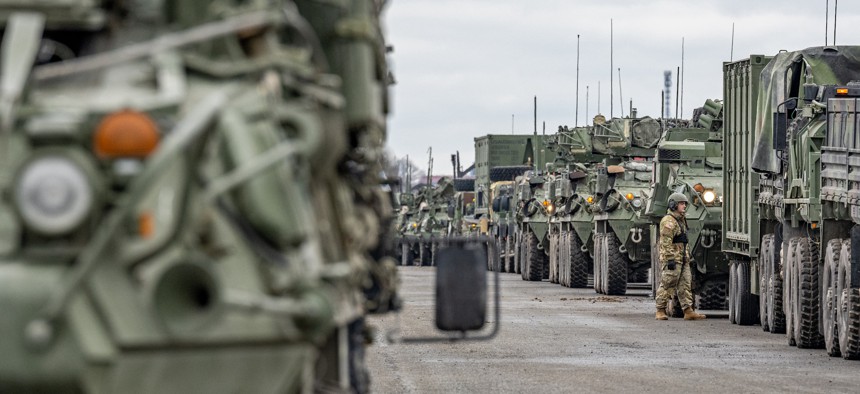
Military vehicles of the U.S. Army stand on the grounds of the Grafenwoehr military training area on Feb 9, 2022. Photo by Armin Weigel/picture alliance via Getty Images
The Army’s New Decades-Long Climate Strategy Has No Budget
The strategy includes a list of tangible objectives but no corresponding cost estimates.
The Army’s new climate strategy includes plans for an all-electric vehicle fleet and calls for microgrids on all of its 130 installations, but no estimates for what everything will cost.
“We’re working through the funding,” Paul Farnan, the acting assistant secretary for Army installations, energy, and environment told reporters on Wednesday. And as technologies “mature and develop,” the funding will continue to be a “moving target.”
Farnan said the changes and shifts outlined in Army Secretary Christine Wormuth’s new strategy aren’t “drastic,” but they are “significant steps forward” and often serve a dual purpose. For example, switching the Army’s vehicle fleet to an electric one will improve the branch’s carbon footprint—but also reduce the audio and heat signature of soldiers in the field. The same goes for establishing microgrids on Army installations.
“We’re seeing that the best resiliency for an installation is to have a self-contained energy generation system rather than depend on anything coming from outside of the base, which has vulnerabilities,” Farnan said.
Dual purpose or not, the Army isn’t sure how much these measures will cost.
“The funding is going to be a moving target,” Farnan said. “This is a strategy that lays out steps…a lot in the coming decade, and even some beyond the next decade.”
The technology is still “maturing and developing,” which makes it difficult to know how much that technology will cost moving forward, Farnan said. A different administration could also change how some of these objectives—with decades-long timelines—are prioritized. Some of the objectives include overarching goals with complicated expenses, costs, and budgets that will certainly evolve in the future—such as net-zero greenhouse gas emissions from Army installations by 2045.
But even the more tangible objectives with much closer deadlines lack a cost estimate. For example, the Army’s all-electric light-duty non-tactical vehicles fleet should be in the field by 2027, according to the climate strategy. But Farnan says the Army is still working with Congress on appropriations and potential partnerships.
“We’re going to be creative,” Farnan said. “We’re going to look at every way to stretch the dollar.”
Not all of the funding will come from “appropriated taxpayer dollars,” Farnan said. There’s “some” funding in the fiscal year 2022 National Defense Authorization Act. There are potentials for partnerships. And, Farnan added, money that previously paid for gas-powered vehicles will, naturally, now pay for electric ones.
“It’s not like we were getting the gas-powered vehicles for free either,” Farnan said.
The Army-specific climate strategy follows the Pentagon’s Climate Adaptation Plan, which was released in October 2021. However, the Pentagon’s plan focused more on how the Defense Department can continue carrying out its mission in the face of climate change, rather than how the Pentagon can contribute to stopping it.
“The Army must adapt across our entire enterprise and purposefully pursue greenhouse gas mitigation strategies to reduce climate risks,” Wormuth said. “If we do not take action now, across our installations, acquisition and logistics, and training, our options to mitigate these risks will become more constrained with each passing year."




